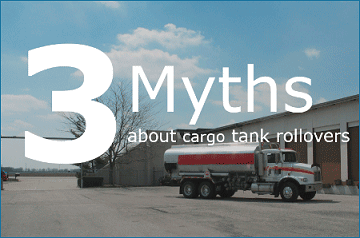You may think you know what causes rollovers, but the actual facts—supplied by the Federal Motor Carrier Safety Administration (FMCSA) — might surprise you.
Myth #1—Rollovers are caused by poor driving conditions, such as curvy roads, rain or darkness.
Facts: Over half (56%) of rollovers occur on straight roads. About 2/3 of rollovers happen during the day, and nearly all of them (93%) occur on dry roads.
Myth #2—Rollovers are caused by speeding or careless driving.
Facts: Surprisingly, these factors aren’t big contributors to rollovers either. Only 28% of all cargo tank accidents involve excessive speed, and evasive maneuvers are a factor in only 5%-10% of rollovers.
Myth #3—Rollovers are only a concern for inexperienced drivers.
Facts: About 66% of rollovers involve drivers with 10 or more years of driving experience. Most rollovers occur among drivers between the ages of 25 and 55.
So driving conditions, speeding and inexperience aren’t at fault in the majority of rollover accidents. What factors DO matter?
Driver Behaviors and Errors
Driver errors are responsible for 78% of rollovers. Factors like drowsiness and inattention contribute to 1 in 5 cargo tank rollovers, and running off the road due to inattention is the leading cause of serious crashes. Drivers can help prevent rollovers by making sure they aren’t fatigued on the job and by driving attentively at all times.
Vehicle Condition
Vehicles should be maintained and inspected regularly. Be especially vigilant for brake issues—in one study, 54% of vehicles in rollovers had a brake defect of some sort.
Load Size
Over 60% of rollover crashes occur with cargo tanks carrying partial loads. Make sure drivers understand the “slosh and surge” effect of liquid loads.
Free Training Resources
For more information about cargo tank rollovers, check out the excellent
rollover prevention resources from the FMCSA, including educational materials and brochures for your drivers. And don’t miss the very effective
Cargo Tank Truck Rollover Prevention video, which outlines why cargo tank trucks are prone to rollovers and how drivers can help control those risk factors.
